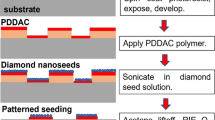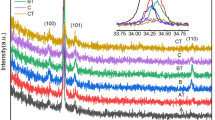Abstract
In this paper, we present a systematic study of the properties of indium phosphide (InP) layers grown by chemical beam epitaxy (CBE). Trimethylindium (TMIn) and phosphine (PH3) are used as source materials. The relation between the phosphine cracker temperature and the cracking efficiency has been studied by mass spectroscopy during growth. The growth rate and morphology of the layers have been studied by varying the TMIn and phosphine flow rates as well as the substrate temperature. We have found that, under a wide range of growth conditions, the deposition rate is only determined by and proportional to the TMIn flow rate. This is in agreement with literature. Additionally, we observe that the growth rate decreases below a certain phosphine to TMIn flow rate (V/III) ratio and becomes phosphine flow limited. From investigations of the growth rate as a function of temperature, it is concluded that the desorption of indium species from InP starts at a temperature slightly below 540°C. For this desorption process, we have found an activation energy of (217 ± 20) kJ/mol. Further characterization of the InP layers has been carried out by photoluminescence and Hall measurements. From both methods, the optimum growth conditions have been established. Under these conditions, we reproduc-ibly obtain InP layers showing linewidths of the donor-bound exciton transition at 5K around 0.25 meV and a mobility at 77K of about 7.0·104 cm2/Vs. From the analysis of the mobility in the temperature range from 20 to 300K, we conclude that, additionally to shallow donors and acceptors, deep-donor centers with an activation energy of about 150 meV are present in all layers.
Similar content being viewed by others
References
W.T. Tsang,J. Vac. Sci. Technol. B 3, 666 (1985).
D.A. Andrews, S.T. Davey, C.G. Tuppen, B. Wakefïeld and G.J. Davies,Appl. Phys. Lett. 52, 816 (1988).
Y. Morishita, S. Maruno, M. Gotoda, Y. Nomura and H. Ogata,J. Cryst. Growth 95, 176 (1989).
A. Rudra, J.F. Carlin, M. Proctor and M. Ilegems,J. Cryst. Growth 111, 589(1991).
H. Heinecke, B. Baur, R. Höger and A. Miklis,J. Cryst. Growth 105, 143 (1990).
J.L. Benchimol, F. Alaoui, Y. Gao, G. Le Roux, E.V.K. Rao and F. Alexandre,J. Cryst. Growth 105, 135 (1990).
M.E. Sherwin, G.O. Munns, M.E. Elta, E.G.Woelk, S.B. Crary, F.L. Terry and G.I. Haddad,J. Cryst. Growth 111, 594 (1991).
J. Ch. Garcia, Ph. Maurel, Ph. Bove and J.P. Hirtz,J. Appl. Phys. 69, 3297 (1991).
MKS Instruction Manual 195-112819A-9/90.
M.B. Panish and R.A. Hamm,J. Cryst. Growth 78, 445 (1986).
M.R. Leys, M.E. Pistol, H. Titze and L. Samuelson,J. Elec- tron. Mater. 18, 25 (1989).
Z.H. Lu, M.C. Hanna, D.M. Szmyd, E.G. Oh and A. Majerfeld,Appl. Phys. Lett. 56, 177 (1990).
W. Steiner, Yu. Zhang and M.L.W. Thewalt,Appl. Phys. Lett. 56, 647 (1990).
H.F. Pen, F.A.J.M. Driessen, S.M. Olsthoorn and L.J. Giling,Semicond. Sci. Technol. 7, 1400 (1992).
T. Inoue, K. Kainosho, R. Hirano, H. Shimakura, T. Kanazawa and O. Oda,J. Appl. Phys. 67, 7165 (1990).
“Properties of Indium Phosphide,” Inspec EMIS Datareviews Series No. 6(1991).
G.E. Stillman and C.M. Wolfe,Thin Solid Films 31, 69 (1976).
D.A. Anderson and N. Apsley,Semicond. Sci. Techn. 1, 187 (1986).
M. Benzaquen, D. Walsh and K. Mazuruk,Phys. Rev. B36, 4388 (1987).
J.S. Blakemore,Semiconductor Statistics (Oxford, England: Pergamon Press, 1962).
D.L. Rode,Semiconductors and Semimetals, vol. 10, ed. R.K. Willardson and A.C. Beer (New York: Academic, 1975).
L. Reggiani,Topics in Applied Physics, vol. 58 (Berlin-Heidel- berg, Germany: Springer-Verlag, 1985).
C. Erginsoy,Phys. Rev. 79, 1013 (1950).
T.C. McGill and R. Baron,Phys. Rev. B 11, 5208 (1975).
W. Waluckiewicz, J. Lagowski, L. Jastrzebski, P. Rava, M. Lichtensteiger, C.H. Gatos and H.C. Gatos,J. Appl. Phys. 51, 2659 (1980).
A. Taguchi and S. Yamada,J. Appl. Phys. 61, 2412 (1987).
M.J. Hafich, H.Y. Lee, P. Silvestre and G.Y. Robinson,J. Cryst. Growth 111, 507 (1991).
T. RaoSudersena, C. Lacelle, M. Davies, R. Barber, P. Chow- Chong, J. McCaffery, S.J. Rolfe, A.P. Roth, B. Benyon and B. Foster,J. Cryst. Growth 136, 179 (1994).
Author information
Authors and Affiliations
Rights and permissions
About this article
Cite this article
Rongen, R., Leys, M.R., Van Hall, P.J. et al. Investigations on indium phosphide grown by chemical beam epitaxy. J. Electron. Mater. 24, 1391–1398 (1995). https://doi.org/10.1007/BF02655454
Received:
Revised:
Issue Date:
DOI: https://doi.org/10.1007/BF02655454




